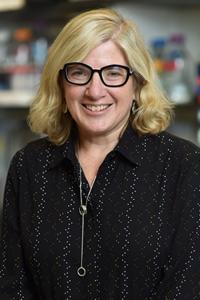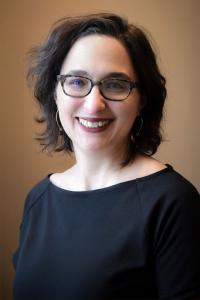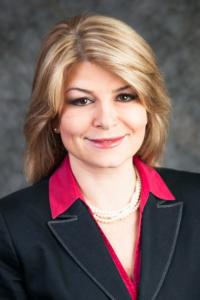
Health Happens Outside of the Hospital
Featured Voice: Ginny Mantello, MD
Meet Ginny Mantello, MD, a member of the Herbert Irving Comprehensive Cancer Center’s (HICCC) Community Advisory Board and director of Health and Wellness at the Office of Staten Island Borough President. Under her civic leadership and her partnership with the HICCC’s Community Outreach and Engagement Office, Dr. Mantello is working to promote health education efforts focused on skin cancer and human papillomavirus (HPV) related cancers and prevention on Staten Island, where the incidence rate for melanoma is substantially higher compared to the rest of New York City. In addition, HPV vaccination rates in Staten Island — at only 27% for adolescents 14 to 17 years old — are lower than all other boroughs in New York City.
Born and raised in Mumbai, Dr. Mantello, who is also an attending radiologist at Montefiore Medical Center, immigrated to New York at age 21 following medical school. A resident of Staten Island for more than 25 years, she became the borough’s first director of Health and Wellness in 2014. Her passion for community engagement is fueled by her belief that health care starts in the community and that all individuals should have equitable access to resources for a healthy lifestyle.
How did you get started in community health and wellness?
A lot of the work I do now is something I learned from my mom. My parents lead by example, showing us how to be kind to others and how to work hard. One of the big things they taught us is to help the community and those less fortunate than us. My mom was very giving of her time. As a physician, she worked at a prestigious hospital where all the celebrities in India went, but she always made time for her free practice. Fast forward to when I took a bit of time off from the hospital and was mostly at home, my daughter asked me to help her at her high school’s Health and Fitness Week. It was a week of workshops and events around nutrition, stress reduction, yoga, meditation, and bringing in all kinds of alternative type of approaches to the school. That is when I realized how much these students needed it. They really, really got into it, and for me, it was just part of who I was and how I was raised. Again, learning from my parents—like many Indians, we were vegetarian, and we were always eating vegetables and grains and also incorporating meditation in our daily routine.
So, that got you hooked.
Yes! I started going to other schools and health fairs and really diving into the community to promote health and wellness. I would invite people to my home and hold workshops for women about healthy eating and lifestyle changes. I started to partner with hospitals as well.
Can you update us on the new skin cancer and HPV awareness grant with your collaborators at the HICCC?
Right now I’m working on pulling all the partners together to get our sun safety programs and HPV vaccination initiatives into the larger agencies based in Staten Island. We want to get some of the work that Dr. Melissa Stockwell has done around using text message reminders as a way to get more parents back to the clinics to complete their child’s HPV vaccinations out to more people. So I’ve pulled in partners that have health-based centers for children, including at Richmond University Medical Center [an official collaborator in the Staten Island grant], and I’m connecting large Staten Island agencies to the HICCC that organize summer programs or afterschool programs—mainly outdoor programs for students—to educate them on sun safety and skin cancer prevention. I’ve gotten partners involved from Snug Harbor Cultural Center, the Goodhue Community Center with the Children’s Aid Society, United Activities Unlimited summer camp and afterschool programs as well as the Jewish Community Center. I have helped organize grand rounds on HPV at our two local hospitals, Richmond University Medical Center and Staten Island University Hospital, with Dr. Ashley Stephens [assistant professor of pediatrics at Columbia] in both medicine and pediatrics so that residents would get trained. We hope that educating the doctors on the new guidance as well as the role of the vaccine in cancer prevention will help change the narrative and improve vaccination rates on Staten Island.
Connecting people seems central to what you do.
I feel like a lot of the work that happens does so in silos. I think we could be so much more effective if we all communicated better and were aligned more closely instead of working in isolation as we often do. I’m a big proponent of the collective impact model. This is a model that we use a lot for our coalition building work, and it is all about bringing people together from different sectors, aligning them towards a common agenda, having constant communication and using a data-driven approach. I think of it as “If you want to go fast, go alone, but if you want to go far, go together.” In order to align everybody and steer them towards a common goal, it takes is someone to be able to look at the whole chessboard, to keep a 30,000 foot perspective. I think of my role is to keep that bird's eye view and be more than just the connector in the community, but also the connector and link between the clinical world and the community.
I say this all the time: What happens in a hospital is not health care, it's sick care. Health truly happens in the community and in order to keep people healthy, you have to meet them in the community and also make the healthy choice the easy choice for them.
And, that’s why community outreach is so key.
Yes. Health happens outside the hospital. If most of the year, 364 days, we are on our own outside in the community, then really, it's those community-based agencies, it's the built environment, it's education and the individual healthy lifestyle choices that people make; all of these things collectively have an impact on our health. It is very important to keep the community informed of resources available to them and to constantly drive the message about the importance of health and wellness. And, most importantly, that it’s not out of reach.
References
HICCC Featured Voices gives our patients, members, and supporters an opportunity to share their personal stories—living with cancer, surviving cancer, researching cancer, and aiming to end cancer.



